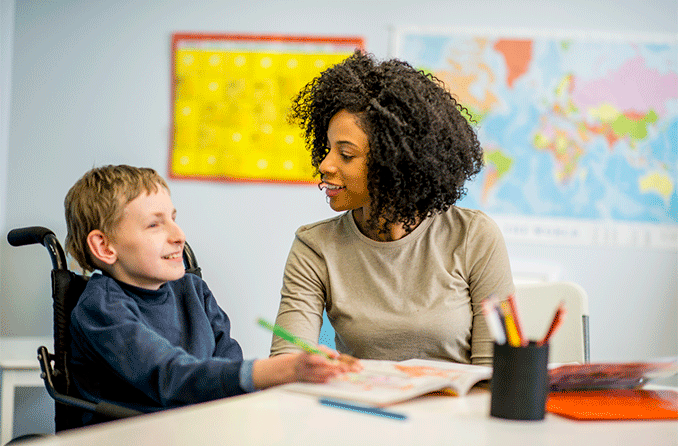How to prepare your visually impaired child to start school or day care
- Understand your child’s educational rights and resources
- Build and assess your child’s social skills
- Practice school behaviors and expectations at home
- Expose your child to school routines and experiences
- Visit the school beforehand
- Meet or speak with your child’s teacher
- Establish a daily routine
- Preparing your visually impaired child to start day care

As many parents know, a child’s first day of school can be an emotional experience, for children and their parents. While the emotions you feel as your child walks into their new school may be complicated, parents typically believe that their child is prepared for whatever school has in store for them.
For parents of a visually impaired child, extra measures of preparation must be taken to ensure their child can learn and thrive in a school environment.
Unsure of where to start? There are several ways to prepare your visually impaired child (and yourself) for their first day of school. Starting early and making sure the necessary resources are available for your child is the key to their success.
Understand your child’s educational rights and resources
As your child begins nearing school age, you should research what resources are available to your child and what their rights are as a visually impaired student.
The Americans with Disabilities Act (ADA) is a piece of legislation passed in 1990 that made it illegal to discriminate against visually impaired and other qualified people in all aspects of public life, including:
Employment
Education
Transportation
All public and private entities open to the general public
The ADA also provides reasonable adjustments for the visually impaired to accommodate their disability in these areas. Under this legislation, a visually impaired child may be eligible for educational resources such as a teacher of students with visual impairments (TVI) or an orientation and mobility (O&M) specialist.
Teachers of students with visual impairments (TVI)
A TVI is not the child’s actual teacher. Rather, they are part of a team that works with the child’s classroom teacher, parents and other educational support staff.
The teacher of students with visual impairments will collaborate with the educational support team by suggesting ways to adapt activities and learning materials to line up with the student’s abilities. They will also spend time with the student to ensure they are following the different subjects presented in class, though TVIs are not considered academic tutors.
One of the most important services a TVI offers is brainstorming with teachers and other educational support staff to create the best possible learning environment for a visually impaired student. Their goal is to promote academic success, encourage independence and help prepare the student for life beyond school.
Orientation and mobility (O&M) specialists
An Orientation and Mobility specialist is a certified instructor who specializes in teaching visually impaired students how to move around cautiously but with efficiency and independence. They typically work with the student directly; however, the O&M specialist may also collaborate with the student’s primary teacher, demonstrating ways to correctly incorporate O&M techniques into the classroom.
O&M specialists train students to learn routes and develop specific skills needed to help them move safely through and within various environments, both indoors and outdoors.
Another aspect of O&M training involves developing a student’s understanding of spatial awareness, environmental knowledge, protective techniques and body image. Students who require the aid of a long cane will be taught helpful techniques for safe and proper use, plus how to incorporate the use of other visual aid devices, including telescopes and monoculars.
To establish the best course of action for the student, the O&M Specialist will assess the student’s particular abilities and needs. With this information, they can determine how to effectively incorporate orientation and mobility techniques into the student’s educational program.
At the time you enroll your child in the upcoming school year, it’s important to notify your preferred school and school district of your child’s disability and ask what resources are available. There may be specific requirements for your child to be eligible for the assistance of a TVI or an O&M specialist.
Communicating your child’s need for additional resources and providing the required information in advance will give the school enough time to implement the accommodations needed to help your child succeed throughout the school year.

Build and assess your child’s social skills
As explained by Dr. Sharon Sacks, Board Chair of Lighthouse for the Blind, nearly 80% of the information we take in while interacting with others is received through our visual sense. As a result, we rely heavily on visual observation to learn how to interact and socialize. If your child has limited or no vision, the cues they would normally observe visually (e.g., a smile or nod) must be communicated in other ways. And they must learn to “read” others in alternative ways.
Social skills work as a foundation upon which success and independence are built. Without the development of social skills, a visually impaired individual may experience isolation, difficulty forming personal relationships, and frustration finding or maintaining employment.
Here are some ways to ensure your visually impaired child develops healthy social skills before they reach school age:
Involve them in family activities
Include your child in casual daily activities with the entire family. For example, while mom and dad are cooking dinner, invite your child to join you in the kitchen or nearby, and incorporate them into conversation about everyone’s day. Encourage them to directly face the person with whom they’re speaking.
If you have multiple children, ask them — your sighted and your visually impaired kids — to include one another in their activities. Siblings commonly treat their disabled brother or sister as they would any other kid, which helps the visually impaired child learn regular social dynamics.
Larger family gatherings also provide important exposure for a visually impaired child because these events help familiarize them with the stimulation of hearing multiple conversations at once. This experience will be particularly beneficial once they enter the classroom, where they will regularly be exposed to external noise.
Take your child out in public often
While involving your child in normal family dynamics and activities is important, they should also experience public outings and interactions with the outside world.
You can start by taking your child with you to the grocery store or when running errands. This helps familiarize them with environments outside the home and normalizes typical daily routines that might otherwise feel overwhelming.
Setting up playdates with other children who are sighted, or those with similar disabilities, allows your child to interact with people outside of their immediate family. This exposure to different personalities, cultures and lived experiences will help develop your child’s flexibility and acceptance of people, places and experiences outside of their norms.

Teach them the difference between public and private behavior
Up to this point, your child has likely spent a lot of time at home. Parents should educate their children (whether they’re visually impaired or not) on what behaviors are appropriate in public settings versus in the privacy of their homes.
For example, teaching your child that throwing a temper tantrum or talking about private body parts in a public place is inappropriate. This trains them to understand the difference between public and private behavior, which will help them throughout their lives.
Give them daily chores and responsibilities
Before your child starts school, they should get a sense of certain responsibilities that will be expected of them in the classroom.
Assigning them chores around the house, such as throwing trash in the trash bin or putting away their toys when they’re done playing, will teach them how to receive and apply instruction from their teachers.
Practice school behaviors and expectations at home
Teaching your child about classroom expectations involves more than their etiquette. Getting your child accustomed to sitting still at a desk and focusing for an extended period will help make the transition easier once they start school.
Create a space in your home that is meant specifically for your child to sit and work. Try to get them excited about having their own workspace and how they’ll have a similar setup at school.
Then, have them sit and focus on practicing braille (if applicable), coloring or working on their handwriting skills. Do this in 20-minute increments and take short breaks in between.
This exercise will build your child’s focusing stamina, which will benefit them in school, as well as other aspects of their lives.
Expose your child to school routines and experiences
Familiarizing your child with the idea of school is critical to preparing them for the next step in their education. A child with no pre-existing understanding of school may be confused by the new change in routine. Planning ahead will also help make the first day of school less stressful for both parent and child.
If your visually impaired child has older siblings, include the visually impaired child in their school night or morning routine. Have them ride in the car when you drop their siblings off at school and/or when you pick them up.
For visually impaired children who don’t have siblings, read books or have them watch educational television that involves school or takes place in a classroom setting. You can also tell them stories about your time in school and mention all of the exciting things you learned and people you met.
Exposing your child to the details of school before their first day can help them get excited and develop their own expectations of the experience.
Visit the school beforehand
It may take some time for your child to adjust to their new surroundings and become comfortable navigating their school and classroom. While an O&M specialist can help with this, it may also prove beneficial for you and your child to visit the school a few times beforehand.
Reach out to the school supervisor and set up times where you and your child can walk around and get a feel for the layout and boundaries of the school. Have them visit the classroom and establish different routes for them to get where they need to go safely and efficiently.
Not only does this get your child more comfortable with the environment, but it also builds their confidence for navigating the space when a parent can’t be there with them.

Meet or speak with your child’s teacher
Having an exceptional child means having open communication with their classroom teacher and anyone else on their education support team. Once you learn who your child’s teacher will be, reach out to them and inform them of your child’s situation.
Provide them valuable information that they can use to modify their curriculum or class layout to accommodate your child. Some important details include:
The specific type of visual impairment your child has
If other disabilities accompany your child’s visual impairment
Whether they use a cane or other objects to assist in their mobility
What level of light they see best in
How to care for your child in case of an emergency
What medications they’re taking, if any
Who to contact in case of an emergency, including the child’s physicians
Any specific requirements or quirks your child may have, related to their disability or otherwise
Whether or not your child likes to be touched for reassurance or guidance
Maintaining a healthy flow of communication with your child’s teacher, and whomever else may be a resource for them, will help ensure their school experience is a positive one.
Establish a daily routine
Creating a routine for any child is important. Working with your visually impaired child to establish what needs to be done on school days will ensure that once school starts, they will be comfortable and cooperative with the routine.
You can do this by writing down the specific morning and nighttime tasks on a whiteboard and placing them in your child’s room. If your child is completely blind or is not of reading age yet, use tactile objects to communicate what needs to be done.
For example, use a bar of soap to remind them of bath time before bed, or a piece of cloth from their backpack to remind them to take it to school with them. Having the routines laid out for the child will help them follow and complete the tasks independently.
Sending your visually impaired child off on their first day of school can be a scary moment for many parents. Starting early in preparing your child for school will not only build their own confidence in their ability to learn and thrive independently, but yours as well.
READ MORE: A guide for parents of visually impaired children
Preparing your visually impaired child to start day care
If your child is not old enough to start school yet, but you plan to enroll them in day care: Planning should be similar to what’s recommended before dropping your child off for their first day of school.
While many of the suggestions outlined above can also be used to prepare your child for day care, here are some additional tips to ease their transition to a new environment:
Find the right day care
Before enrolling your child in day care — whether they’re visually impaired or not — it’s wise to research your options and make an informed decision. Relying on customer reviews and recommendations from friends is a good way to find a day care that meets your and your child’s needs.
When looking into a day care for your child, plan to ask the following questions:
Do the teachers have training and experience working with visually impaired or diabled children? Will they incorporate certain learning techniques that accommodate your child?
Does the day care have a philosophy that accepts and embraces children with visual impairment or other disabilities? Do the teachers and staff reflect that philosophy in how they treat a disabled child?
Is the environment accessible for your child? Do they have the necessary learning and developmental materials?
How collaborative is the day care center with a child’s parents? How are potential issues communicated and handled?
How many teachers and children are in each classroom? Do the children appear happy and engaged? Do the teachers?
Can you trust the teachers and staff to take care of your child? Can they provide your child with the individual attention they require?
In addition to asking these questions, you can access the Childcare.gov website and search by state to find resources to research day cares and other childcare opportunities in your state.
Describe unfamiliar noises
Even for children who have full vision, the many competing sounds of a day care center can be overwhelming. Start exposing your child to the various noises they may experience in a day care — describe to them what is causing the noise and what it means.
Some examples of this may be the tick-tocking of an analog clock, the scraping of a pencil sharpener or the various noises made by unfamiliar toys.
Expose your child to objects they may play with at day care
Have your child become familiar with items that they will likely come into contact with at day care. Some examples of this may include glue, play-doh, paint and other craft items. Explain to them what the item is called and what it’s used for.
Use your voice to communicate how you feel
Because visually impaired children can’t typically use facial expressions to determine a person’s mood, they often rely on someone’s vocal tone and volume. When they’re still developing the skill, it’s important to tell your child how you feel and emphasize it with the tone of your voice.
For instance, if you’re upset, use a stern tone of voice and tell them, “I’m upset because...” This helps them build the connection between vocal tone and emotion, which will benefit them once they’re in day care and around new people.
Get the child accustomed to being away from you
If the resources are available, practice leaving your child with a family member or friend for a short time, such as while you go grocery shopping. This will give you some indication as to how your child will react when you drop them off at day care.
When you return, it’s recommended that you give your child details about where you went and what you did, as well as asking them what they did while you were away. Conversations like these can help ease any anxiety a child may feel when left in an unfamiliar environment.
Sending your visually impaired child off on their first day of school or day care can be a scary moment for many parents. Starting early in preparing your child will not only build their own confidence in their ability to learn and thrive independently, but yours as well.
READ NEXT: Sensory overload: A guide for people with low vision
What is the Americans with Disabilities Act (ADA)?. ADA National Network. Accessed March 2021.
Teachers of Students with Visual Impairments. Teaching Students with Visual Impairments. April 2020.
Orientation & Mobility Specialist. Teaching Students with Visual Impairments. April 2020.
Developing social skills in children who are blind or visually impaired. Perkins School for the Blind. Accessed March 2021.
6 tips for preparing for the first day of preschool. Paths to Literacy for students who are blind or visually impaired. August 2018.
Prepare a visually impaired child for day care. Children’s Hospital of Los Angeles. Accessed March 2021.
Day Care for Children with Disabilities. Navigate Life Texas. Accessed June 2021.
Page published on Wednesday, April 14, 2021






